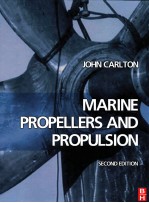图书介绍
MARINE PROPELLERS AND PROPULSION SECOND EDITIONPDF|Epub|txt|kindle电子书版本网盘下载

- J S CARLTON 著
- 出版社: ELSEVIER
- ISBN:0750681500
- 出版时间:2007
- 标注页数:533页
- 文件大小:110MB
- 文件页数:552页
- 主题词:
PDF下载
下载说明
MARINE PROPELLERS AND PROPULSION SECOND EDITIONPDF格式电子书版下载
下载的文件为RAR压缩包。需要使用解压软件进行解压得到PDF格式图书。建议使用BT下载工具Free Download Manager进行下载,简称FDM(免费,没有广告,支持多平台)。本站资源全部打包为BT种子。所以需要使用专业的BT下载软件进行下载。如BitComet qBittorrent uTorrent等BT下载工具。迅雷目前由于本站不是热门资源。不推荐使用!后期资源热门了。安装了迅雷也可以迅雷进行下载!
(文件页数 要大于 标注页数,上中下等多册电子书除外)
注意:本站所有压缩包均有解压码: 点击下载压缩包解压工具
图书目录
1 The early development of the screw propeller1
2 Propulsion systems11
2.1 Fixed pitch propellers13
2.2 Ducted propellers15
2.3 Podded and azimuthing propulsors17
2.4 Contra-rotating propellers18
2.5 Overlapping propellers19
2.6 Tandem propellers19
2.7 Controllable pitch propellers20
2.8 Waterjet propulsion23
2.9 Cycloidal propellers23
2.10 Paddle wheels24
2.11 Magnetohydrodynamic propulsion26
2.12 Superconducting motors for marine propulsion28
3 Propeller geometry31
3.1 Frames of reference33
3.2 Propeller reference lines33
3.3 Pitch34
3.4 Rake and skew37
3.5 Propeller outlines and area39
3.6 Propeller drawing methods42
3.7 Section geometry and definition42
3.8 Blade thickness distribution and thickness fraction47
3.9 Blade interference limits for controllable pitch propellers48
3.10 Controllable pitch propeller off-design section geometry48
3.11 Miscellaneous conventional propeller geometry terminology50
4 The propeller environment51
4.1 Density of water53
4.2 Salinity53
4.3 Water temperature54
4.4 Viscosity55
4.5 Vapour pressure55
4.6 Dissolved gases in sea water56
4.7 Surface tension56
4.8 Weather58
4.9 Silt and marine organisms61
5 The wake field63
5.1 General wake field characteristics65
5.2 Wake field definition65
5.3 The nominal wake field68
5.4 Estimation of wake field parameters69
5.5 Effective wake field71
5.6 Wake field scaling74
5.7 Wake quality assessment77
5.8 Wake field measurement79
6 Propeller performance characteristics87
6.1 General open water characteristics89
6.2 The effect of cavitation on open water characteristics94
6.3 Propeller scale effects95
6.4 Specific propeller open water characteristics98
6.5 Standard series data101
6.6 Multi-quadrant series data118
6.7 Slipstream contraction and flow velocities in the wake123
6.8 Behind-hull propeller characteristics131
6.9 Propeller ventilation132
7 Theoretical methods — basic concepts137
7.1 Basic aerofoil section characteristics140
7.2 Vortex filaments and sheets142
7.3 Field point velocities144
7.4 The Kutta condition146
7.5 The starting vortex146
7.6 Thin aerofoil theory147
7.7 Pressure distribution calculations151
7.8 Boundary layer growth over an aerofoil155
7.9 The finite wing159
7.10 Models of propeller action162
7.11 Source and vortex panel methods164
8 Theoretical methods — propeller theories167
8.1 Momentum theory — Rankine (1865); R.E.Froude (1887)169
8.2 Blade element theory —W.Froude (1878)171
8.3 Propeller Theoretical development (1900—1930)172
8.4 Burrill’s analysis procedure (1944)174
8.5 Lerbs analysis method (1952)177
8.6 Eckhardt and Morgan’s design method (1955)182
8.7 Lifting surface correction factors — Morgan et aL.186
8.8 Lifting surface models189
8.9 Lifting-line — lifting-surface hybrid models192
8.10 Vortex lattice methods192
8.11 Boundary element methods197
8.12 Methods for specialist propulsors198
8.13 Computational fluid dynamics methods200
9 Cavitation205
9.1 The basic physics of cavitation207
9.2 Types of cavitation experienced by propellers212
9.3 Cavitation considerations in design219
9.4 Cavitation inception228
9.5 Cavitation-induced damage233
9.6 Cavitation testing of propellers235
9.7 Analysis of measured pressure data from a cavitating propeller239
9.8 Propeller—rudder interaction240
10 Propeller noise247
10.1 Physics of underwater sound249
10.2 Nature of propeller noise253
10.3 Noise scaling relationships256
10.4 Noise prediction and control258
10.5 Transverse propulsion unit noise259
10.6 Measurement of radiated noise260
11 Propeller—ship interaction263
11.1 Bearing forces265
11.2 Hydrodynamic interaction278
12 Ship resistance and propulsion285
12.1 Froude’s analysis procedure287
12.2 Components of calm water resistance289
12.3 Methods of resistance evaluation298
12.4 Propulsive coefficients310
12.5 The influence of rough water312
12.6 Restricted water effects314
12.7 High-speed hull form resistance314
12.8 Air resistance316
13 Thrust augmentation devices319
13.1 Devices before the propeller321
13.2 Devices at the propeller324
13.3 Devices behind the propeller327
13.4 Combinations of systems328
14 Transverse thrusters331
14.1 Transverse thrusters333
14.2 Steerable internal duct thrusters340
15 Azimuthing and podded propulsors343
15.1 Azimuthing thrusters345
15.2 Podded propulsors346
16 Waterjet propulsion355
16.1 Basic principle of waterjet propulsion357
16.2 Impeller types359
16.3 Manoeuvring aspects of waterjets360
16.4 Waterjet component design361
17 Full-scale trials367
17.1 Power absorption measurements369
17.2 Bollard pull trials375
17.3 Propeller-induced hull surface pressure measurements377
17.4 Cavitation observations377
18 Propeller materials381
18.1 General properties of propeller materials383
18.2 Specific properties of propeller materials386
18.3 Mechanical properties390
18.4 Test procedures392
19 Propeller blade strength395
19.1 Cantilever beam method397
19.2 Numerical blade stress computational methods402
19.3 Detailed strength design considerations405
19.4 Propeller backing stresses408
19.5 Blade root fillet design408
19.6 Residual blade stresses409
19.7 Allowable design stresses410
19.8 Full-scale blade strain measurement413
20 Propeller manufacture417
20.1 Traditional manufacturing method419
20.2 Changes to the traditional technique of manufacture423
21 Propeller blade vibration425
21.1 Flat-plate blade vibration in air427
21.2 Vibration of propeller blades in air428
21.3 The effect of immersion in water430
21.4 Simple estimation methods430
21.5 Finite element analysis431
21.6 Propeller blade damping432
21.7 Propeller singing433
22 Propeller design435
22.1 The design and analysis loop437
22.2 Design constraints438
22.3 The choice of propeller type439
22.4 The propeller design basis442
22.5 The use of standard series data in design445
22.6 Design considerations449
22.7 The design process458
23 Operational problems465
23.1 Performance related problems467
23.2 Propeller integrity related problems472
23.3 Impact or grounding474
24 Service performance and analysis477
24.1 Effects of weather479
24.2 Hull roughness and fouling479
24.3 Hull drag reduction486
24.4 Propeller roughness and fouling486
24.5 Generalized equations for the roughness-induced power penalties in ship operation489
24.6 Monitoring of ship performance493
25 Propeller tolerances and inspection503
25.1 Propeller tolerances505
25.2 Propeller inspection506
26 Propeller maintenance and repair511
26.1 Causes of propeller damage513
26.2 Propeller repair515
26.3 Welding and the extent of weld repairs517
26.4 Stress relief518
Bibliography521
Index525